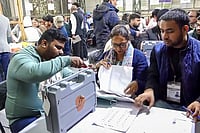ANYONE who has read a detective story knows that where there is a crime, there must be a motive. Anyone who is familiar with social anthropology knows that where there is a culture, there is an underlying system of beliefs. A combination of hidden or not-so-hidden personal motives, coupled with a system of shared beliefs in half-baked economic ideas, also characterise the approach to economic reforms and liberalisation in India. Like the anthropologist studying the tribe, we need to find that 'hidden script' which the tribe of liberalisers share in common.
The Belief System
The Indian macroeconomic stabilisation programme was guided by the economic philosophy of the IMF. It targeted on reducing the twin deficits in government (public) finance and in the current account of the balance of payments. The definitions of concepts such as gross domestic product/gross national product (GDP/GNP) or national income make it necessary for the consistency of these definitions to ensure that the deficit in public finance equals exactly the deficit in the current account of the balance of payments, provided private income equals private expenditure. In simpler words, with the private sector assumed to make both ends meet, the excess spending by the Government has to be paid for by excess borrowing from foreigners or from abroad.
Economists, especially those in favour of liberalisation, seldom make clear that such definitional equality is a mere truism, it is not an explanation. 'It rains on a rainy day' is a truism. It does not explain why it rains or when rain is to be expected. Similarly, the twin deficit definition does not identify any mechanism by which a reduction in the Government deficit will lead to a reduction in the trade deficit or the balance of payments deficit. But the IMF believes that there is such a mechanism.
Like most of economic theory, the mechanism must work either through 'prices' or through 'quantities' (or some combination of both). A stark outline of the price-story would be the following: an increase in Government spending, given its revenue, (a higher Government deficit) will cause inflation, hence raising prices for goods produced in India. As a result (at a given exchange rate), people will buy cheaper foreign goods rather than Indian goods which will widen our trade (or balance of payments) deficit. Thus, the size of the trade deficit will increase until it matches the government deficit. In this way, it will restore the definitional truism mentioned above (assuming private sector income and expenditure is throughout in balance). A similar mechanism would also work in the opposite direction. A reduction in the Government deficit would correspondingly reduce the trade deficit by making us more price competitive in the world market. This theory can be embellished in many ways with algebraic 'models', statistics or historical anecdotes, but the basic storyline remains. And this is the story-line the IMF advocates, which is shared, almost uncritically, by its admirers in our government or academia.
But there is an alternative story based on quantities or outputs and incomes, rather than prices. As the Government reduces its expenditure and deficit, the purchasing power in the economy falls, to begin with directly in the Government sector, and then indirectly in the private sector for producers and workers who supply to meet the demand from the Government. The result is an overall magnified fall in the purchasing power much larger than the original reduction in the Government deficit. Economists call it the 'multiplier' mechanism. We think that, in India, it could be something like three times the original reduction in the Government deficit. This fall in purchasing power means a shrinking market at home for selling goods, typically leading to loss of income and employment all around. It is this falling income and purchasing power which reduces imports until the trade (or the balance of payments) deficit is reduced again to match the reduced government deficit.
This latter 'income adjustment' story, unlike the former 'price adjustment' story, is not encouraged by the belief system of the IMF and the Government mandarins. But that does not make it any less plausible or probable. Indeed, in country after country undergoing IMF-style stabilisation in Latin America, Africa, Asia, or East Europe, its plausibility has been established over and over again. Evidence is now irrefutable that a substantial reduction in the Government deficit reduces the trade deficit very significantly through a reduction in the level of economic activity—employment and output—rather than by simply reducing the rate of inflation in the country attempting stabilisation. This is the politically awkward economic aspect of pushing too far with attempts to reduce Government deficits. It may reduce the trade deficit only at a great social cost.
THE teams from the IMF and the World Bank that visit developing countries, or their home-grown supporters, go for a number-crunching game based on a whole set of arbitrary (and non-transparent) assumptions which rest fundamentally on the belief that price—rather than quantity—adjustment is the most crucial issue. This they ensure through the convenient assumption that the output fall due to stabilisation through deficit reduction would be relatively little. It is almost an exercise in fudging which is not easy to catch. Like the magician putting the rabbit into the hat to take it out again, these assumptions are put in simply to generate convenient numbers. Thus, the 'quantity theory of money'—a particular favourite of the IMF—is used on the assumption that any fall in the quantity of real output is 'exogenous'. Strangely enough, this is a matter of assumption for the IMF and not something determined by how much the reduction in Government deficit would reduce output through depressing the purchasing power in the economy!
It is such intentional negligence of inconvenient economic outcomes which makes reliance on IMF-style stabilisation bad economics and bad politics in many situations.
From Belief System to Reward System
Academic economists find it inconvenient to question the dominant orthodoxy, the so-called 'Washington Consensus', for the simple reason that it is not good for their careers; especially, if they come from the Third World. The international reward system is such that attractive jobs, not only in the IMF or the World Bank, but even prestigious academic appointments, are often far easier to get if one sticks to the narrow virtuous path of conventional wisdom. Much the same is true for the national reward system in developing countries where the patronage of the State is an important source of career development in academia and elsewhere in the system.
Journalists in India commenting on economic affairs are only a step removed from academic economists. Less concerned with the theoretical validity of IMF-style stabilisation, one of their main jobs in this respect is to monitor the day-to-day consequences of economic reforms. Facts usually come from the same government whose performance is being monitored to create a bias of selectivity, if not distortion. More importantly, the patronage of the State becomes a stronger factor for career advancement in journalism than in academia. On top of that, there is the inevitable lure of globalisation in a poor country. If the typical academic economist aspires to a cushy job, or a consultancy, abroad through a path of least intellectual resistance, there is no reason why a journalist would not be lured by the lucrative prospect of being associated with, say, The Wall Street Journal, Financial Times or even the house journals of the World Bank. Not surprisingly, liberalisation gets an exceptionally good press in English but less so in Indian languages.
For bureaucrats in the Third World, the reward system is even more straightforward. A few years 'on deputation' in the World Bank or the IMF means a sojourn in Washington DC at enormous salaries (compared with what they earn at home) to be followed by untaxable dollar pensions which provide enough money for a secured retired life. Not surprisingly, most civil servants in the Ministry of Finance who have dealt with the World Bank or the IMF in recent times, and toed their line meekly or pushed it aggressively, have found themselves on such deputations. The unwritten rule is to push unquestioningly the IMF-World Bank line and be rewarded at an appropriate time.
There is yet another dimension to this phenomenon. Many young economists from the Third World trained in the United States join the World Bank or the IMF as professional staff, repeating more or less mindlessly the received economic orthodoxy of 'stabilisation and structural adjustment' verbatim in country after country, while 'on mission', as the path of least resistance to a cushy career. Some of them move 'on leave' to the Ministry of Finance, the central bank or other important places in the Government in their home countries. With the passage of time and with considerable help from their erstwhile (or continuing) employers in Washington DC, these economists-turned-bureaucrats come to occupy high, sometimes strategic, positions. This makes for an interesting two-way movement. There are some who are on leave from the government working in the World Bank or the IMF and there are others who are on leave from the World Bank or the IMF working in the government. After a time, it becomes impossible to discern who is on leave from where, for these movements are not once-and-for-all. For some of these mandarins, it would seem that there is a revolving door between the Ministry of Finance in New Delhi (or elsewhere in the developing world) and the World Bank or the IMF in Washington DC.


























